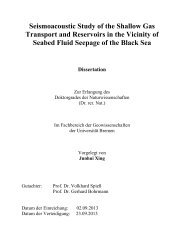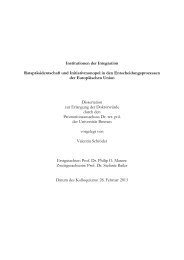Slope stability along active and passive continental margins ... - E-LIB
Slope stability along active and passive continental margins ... - E-LIB
Slope stability along active and passive continental margins ... - E-LIB
Create successful ePaper yourself
Turn your PDF publications into a flip-book with our unique Google optimized e-Paper software.
2 Geotechnical characteristics <strong>and</strong> slope <strong>stability</strong> <strong>along</strong> the Uruguayan <strong>and</strong> northern Argentine margin<br />
marine deposits (Bryn et al. 2005). These fine-grained contouritic deposits are likely responsible for<br />
staircase appearance of headwalls <strong>and</strong> retrogressive behavior of the Storegga l<strong>and</strong>slide. In our study<br />
area offshore Uruguay <strong>and</strong> northern Argentina, bottom currents are also responsible for the distinct<br />
morphologies between NS <strong>and</strong> SC. Currents also control sedimentation pattern, which in turn exert key<br />
control on slope <strong>stability</strong> precondition (see more detail in 2.5.3; Preu et al. 2013).<br />
2.6 Conclusions<br />
This paper presents sedimentological, physical <strong>and</strong> geotechnical results of the slope <strong>and</strong> canyon areas<br />
<strong>along</strong> the Uruguayan <strong>and</strong> Northern Argentine slope, which were used to compare the differences of<br />
preconditioning factors, triggering mechanisms <strong>and</strong> slope failure modes between open slope <strong>and</strong><br />
canyon.<br />
The NS region is characterized by a pattern of steep scarps on the gentle slope. With joint roles of<br />
fluvial discharge of the Rio de la Plata River <strong>and</strong> low-energy contour current, the sedimentary<br />
succession of NS is dominated by fine-grained material. Due to high undrained shear strength <strong>and</strong><br />
moderate drained shear strength parameters, the slope <strong>along</strong> NS is stable <strong>and</strong> slope failure is unlikely<br />
under the current conditions. <strong>Slope</strong> failures are expected to occur for moderate earthquakes (M 4) in the<br />
NS are or strong events (e.g., M = 7) in epicentral distances < 15 km.<br />
The SC region is characterized by slope failure at the canyon headwall <strong>and</strong> flanks with mass transport<br />
deposits stacked at the canyon mouth. Strong contour currents induced by the BMC are extensive<br />
reworking the downslope driven sediments <strong>and</strong> incorporating them into the s<strong>and</strong>y contourites. With<br />
low undrained shear strength, the slope of SC has a low <strong>stability</strong> under current conditions. Small-scale<br />
slope failures occur both during static conditions <strong>and</strong> certainly during infrequent seismic events such as<br />
moderate earthquakes in the near-field or strong earthquake (e.g., M = 7) in the far-field (epicentral<br />
distance < 45 km).<br />
A comparison with submarine l<strong>and</strong>slide studies on other <strong>passive</strong> <strong>continental</strong> <strong>margins</strong> reveals that<br />
different oceanographic <strong>and</strong> sedimentary settings result in different styles submarine mass movements<br />
in different <strong>passive</strong> <strong>continental</strong> <strong>margins</strong> (Krastel et al. accepted), while earthquake as additional<br />
triggering mechanism might be considerable for various settings. It is thus vital important that<br />
integration of geological, sedimentological, physical <strong>and</strong> geotechnical information to better<br />
underst<strong>and</strong>ing of submarine mass movements is approached by means of combined slope <strong>stability</strong> <strong>and</strong><br />
earthquake analysis, as proposed in this study for the Uruguayan <strong>and</strong> northern Argentine margin.<br />
Acknowledgements<br />
We thank the captain <strong>and</strong> crew of the RV Meteor for their support during the cruise M78/3. Matthias<br />
Lange is thanked for outst<strong>and</strong>ing technical assistance with the geotechnical laboratory devices. This<br />
study is funded through DFG-Research Center/Cluster of Excellence “The Ocean in the Earth System”<br />
as well as the Chinese Scholarship Council.<br />
60
















